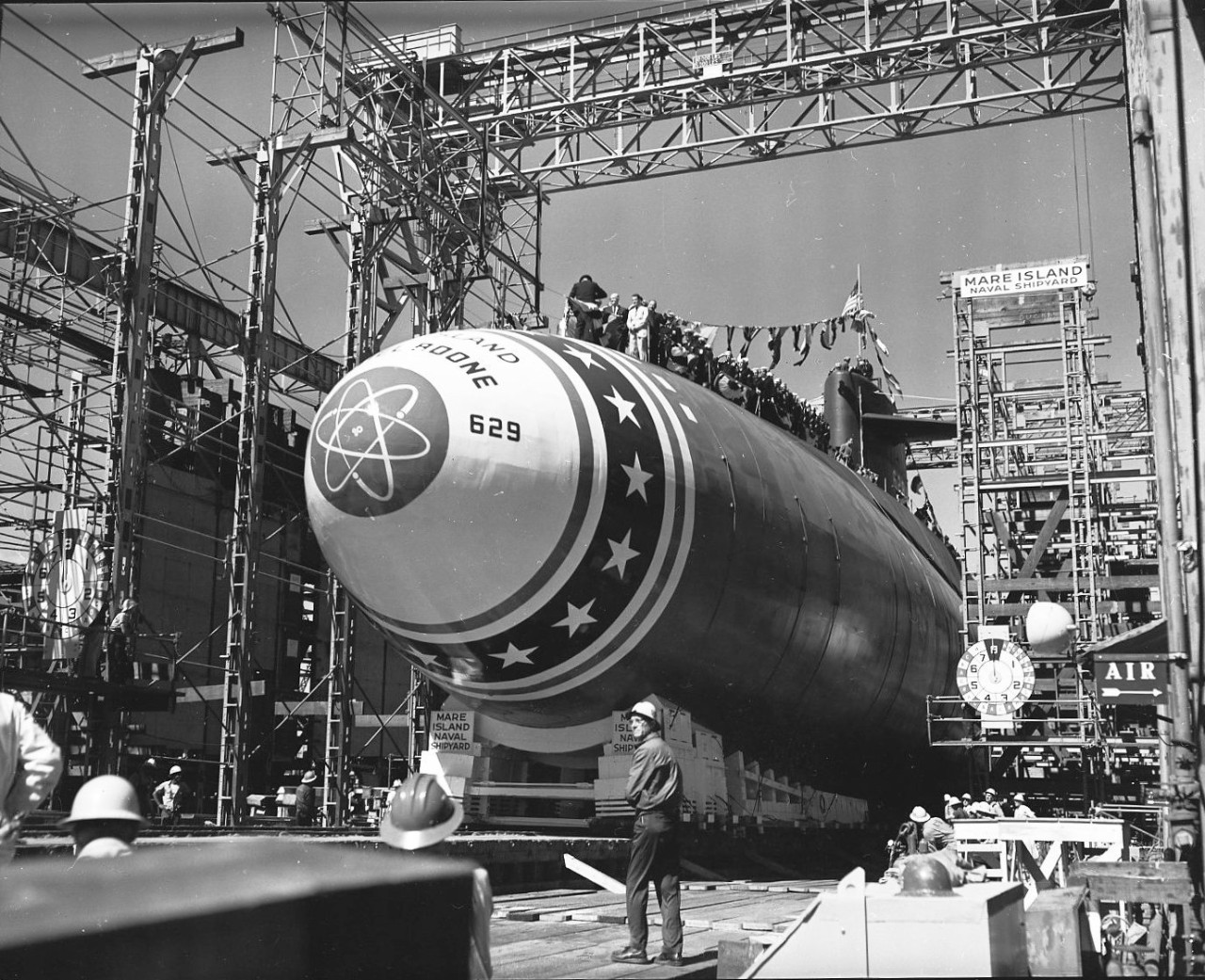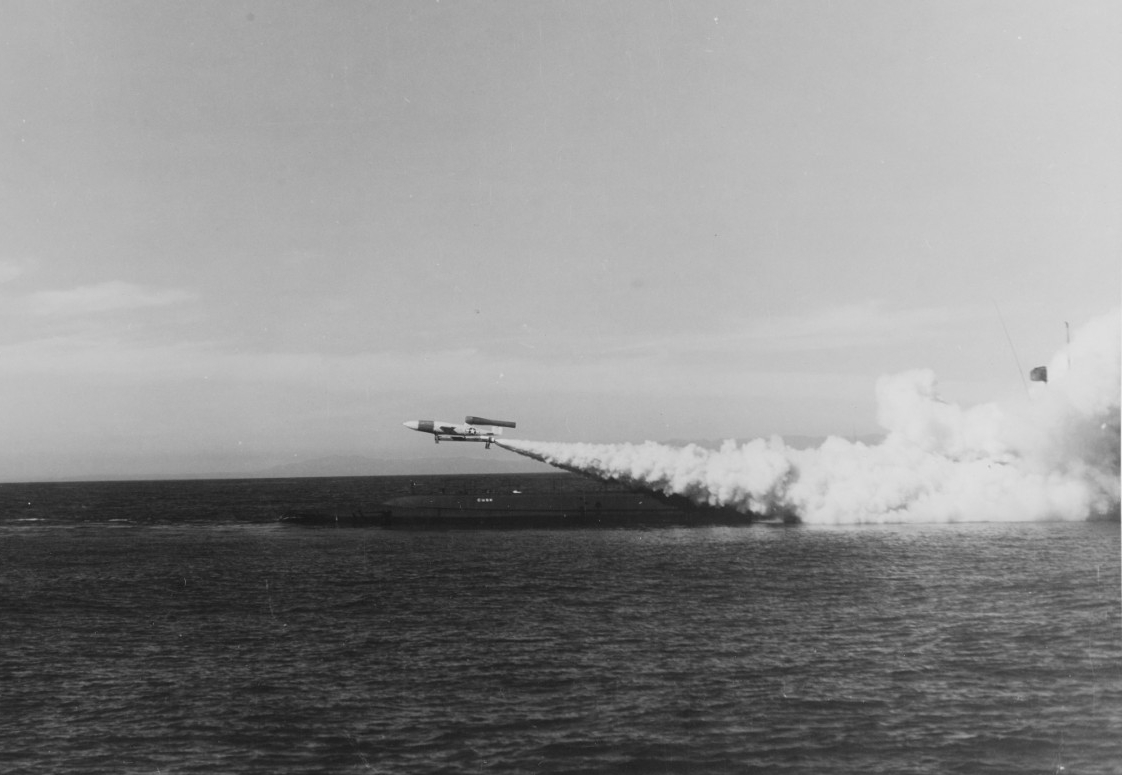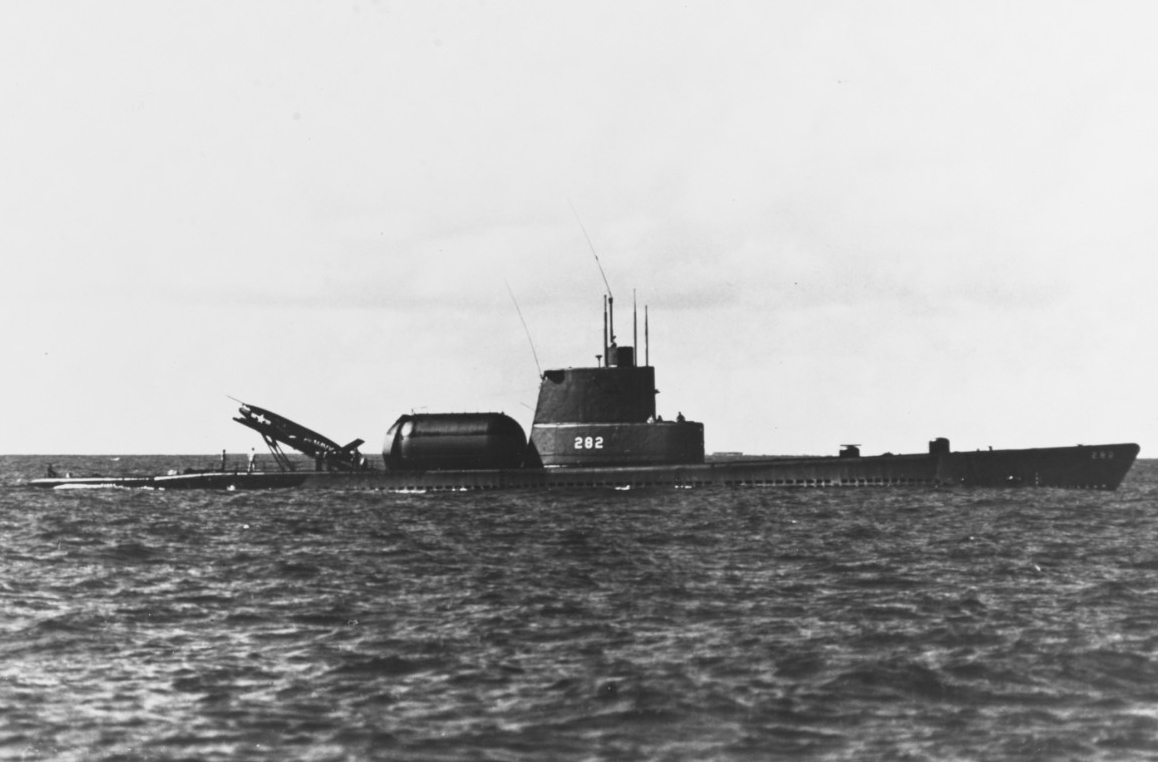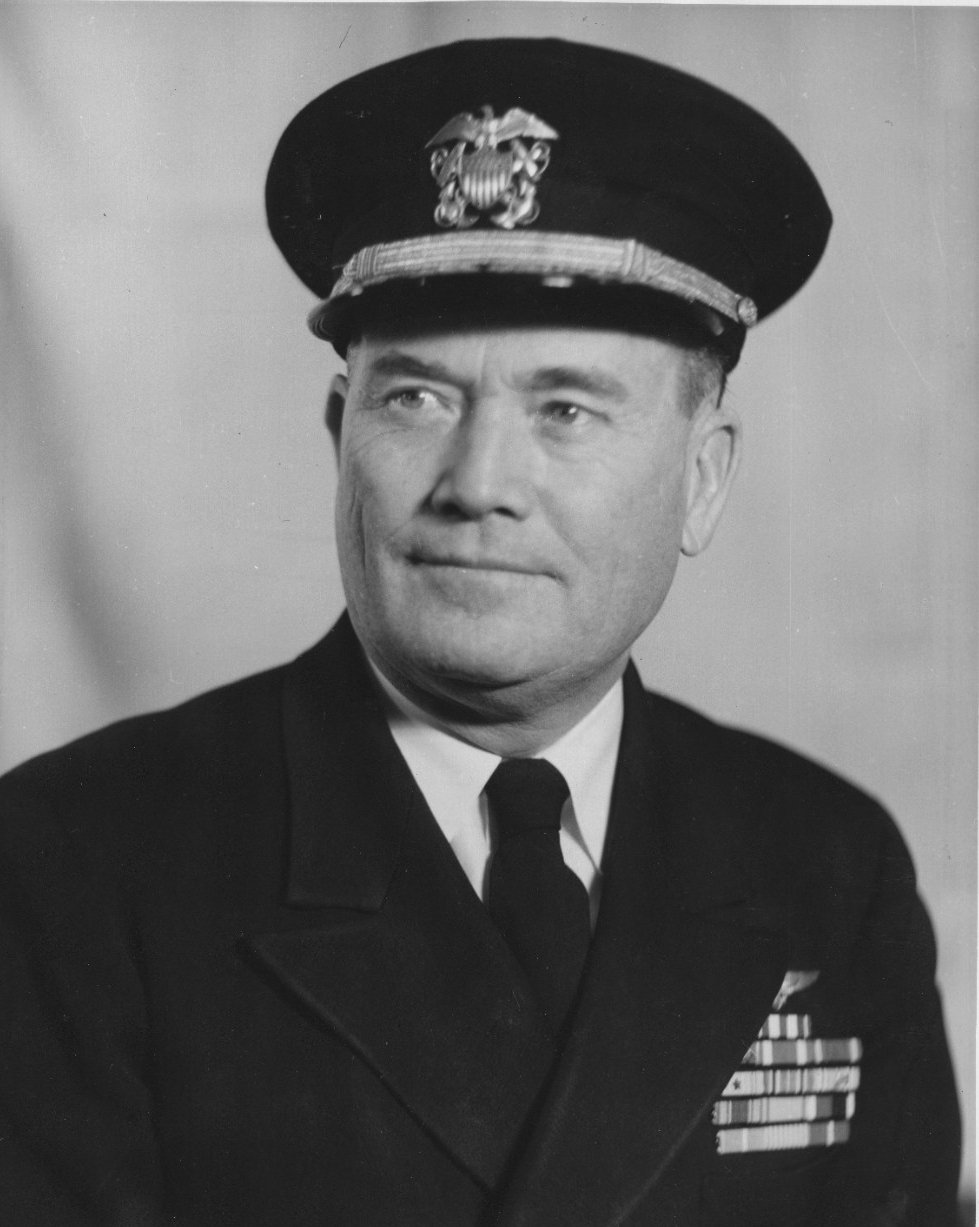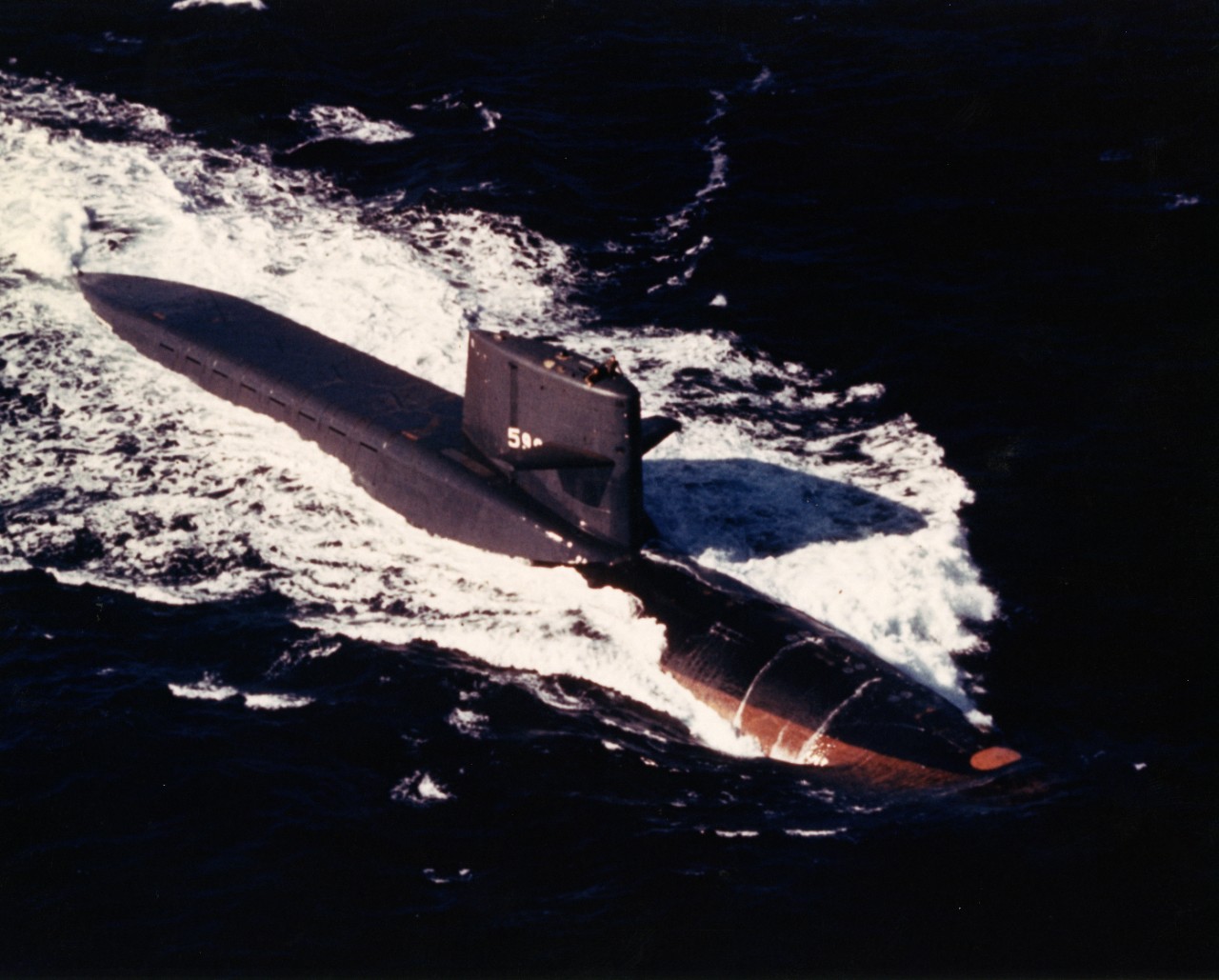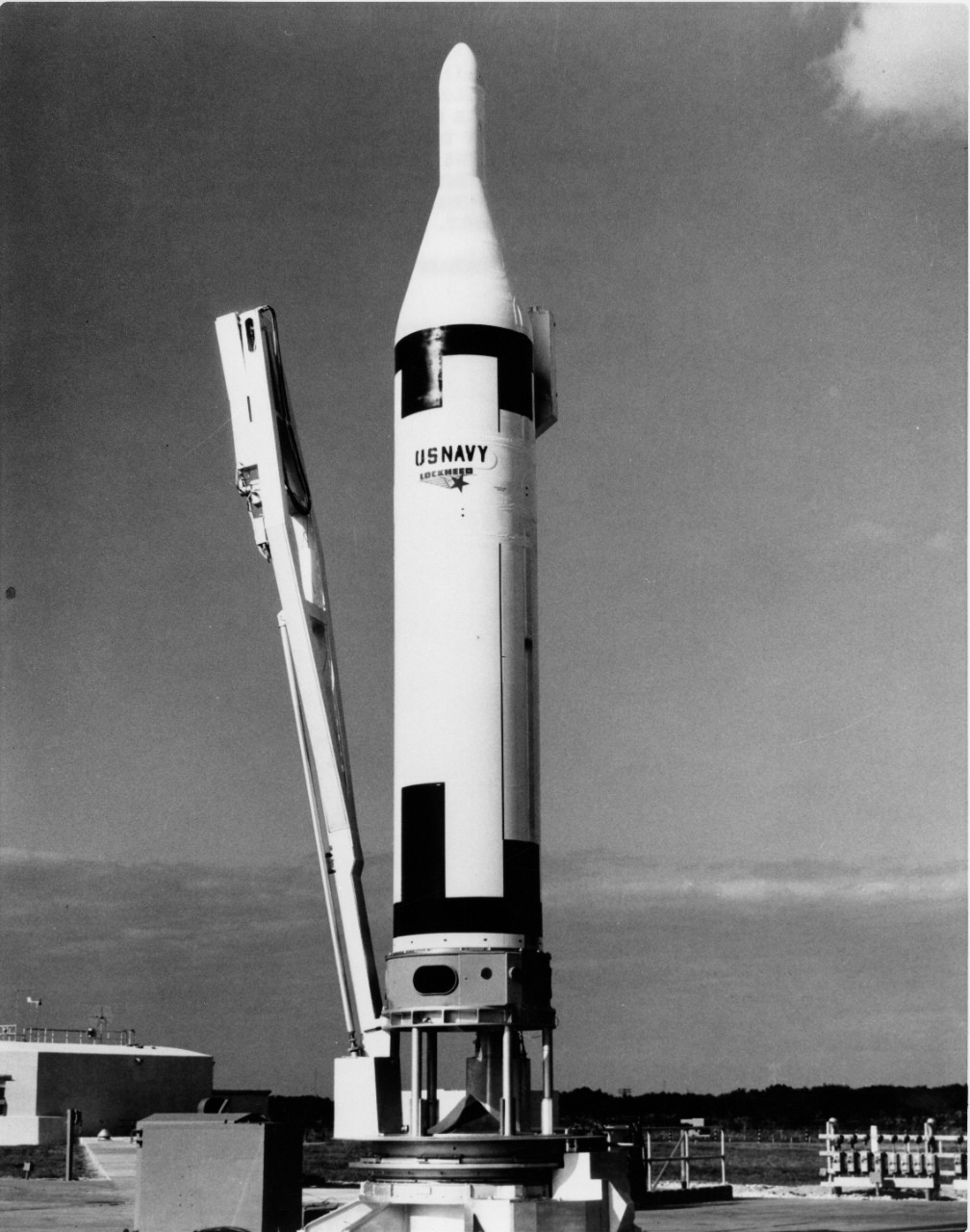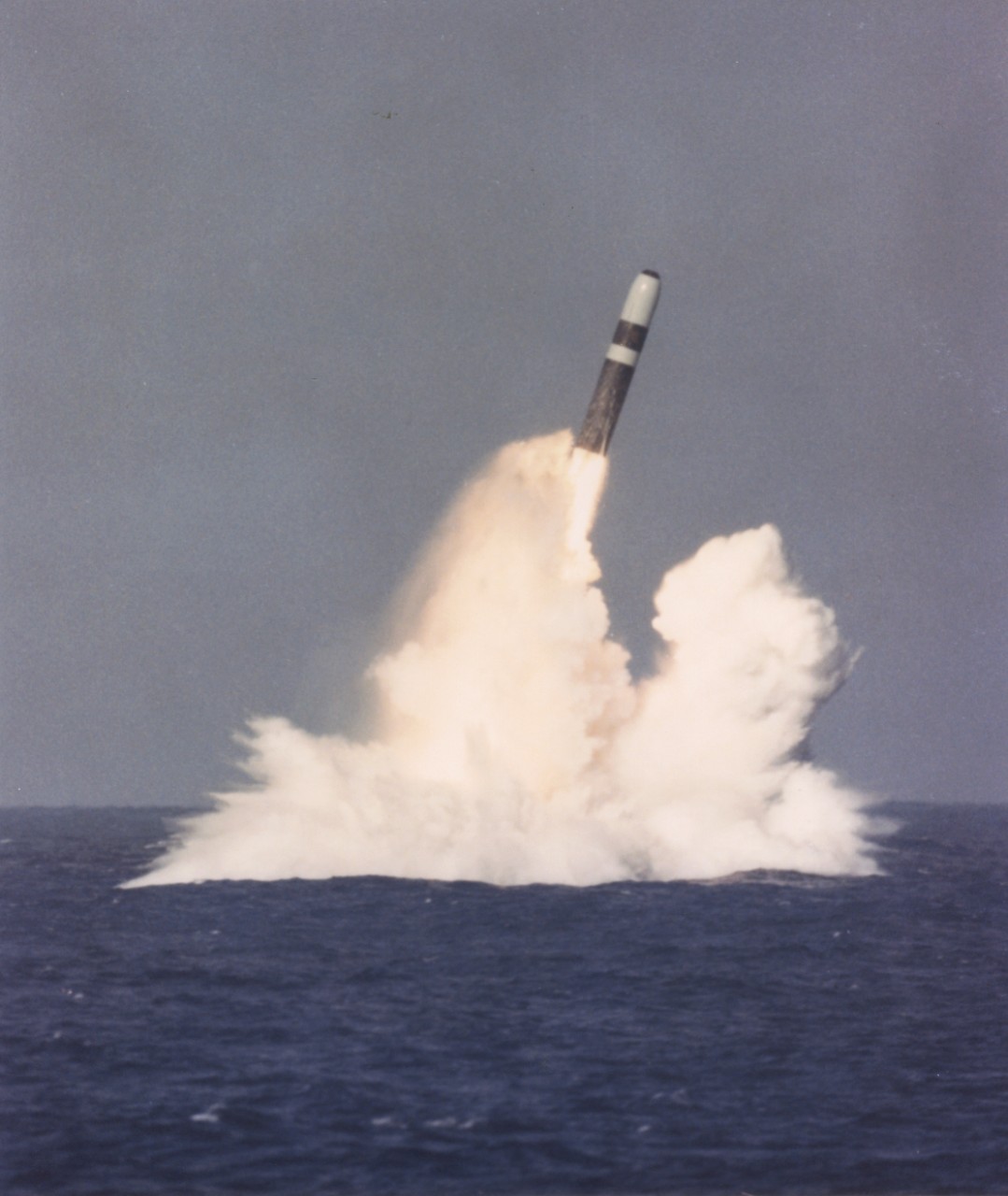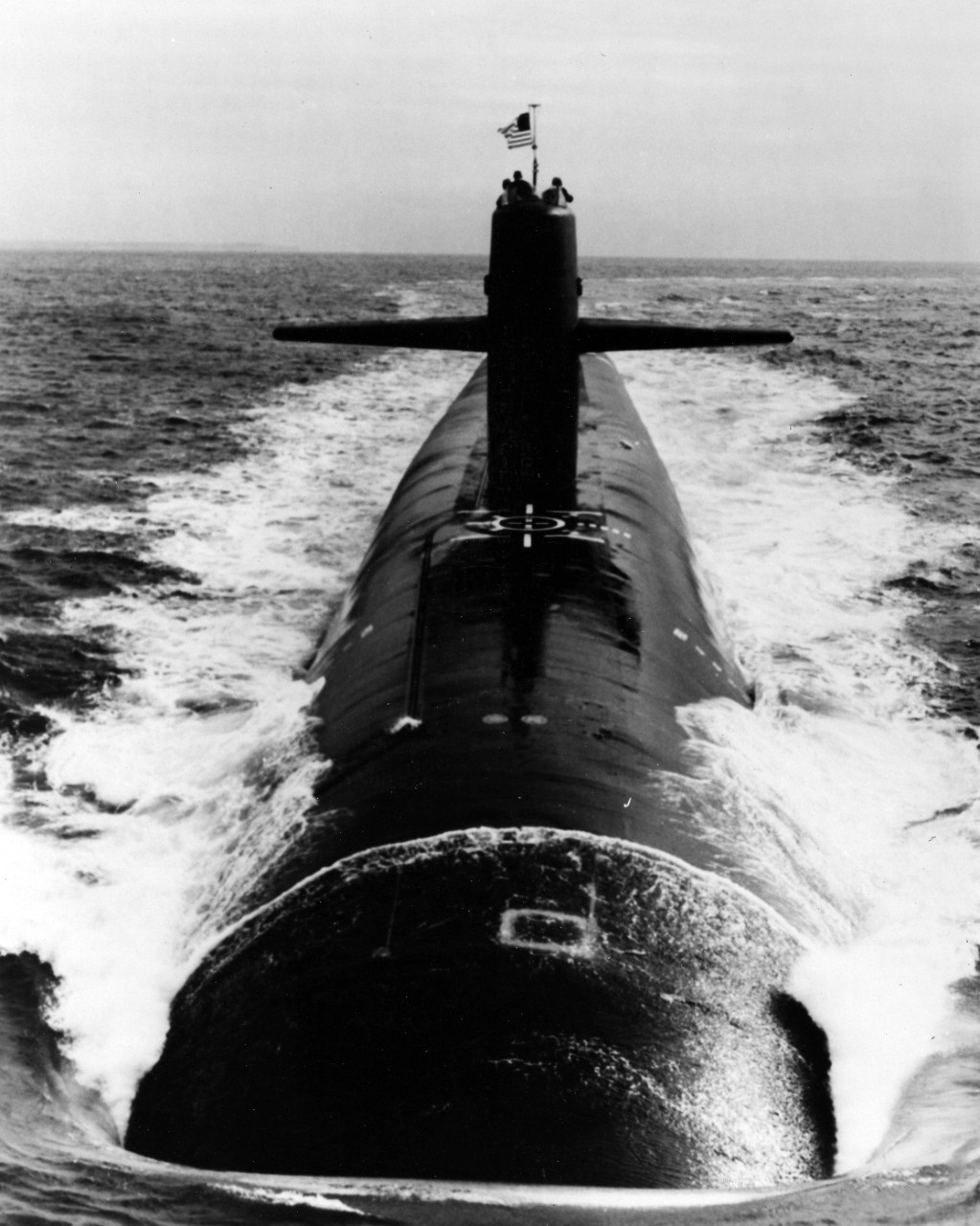A Brief History of U.S. Navy Fleet Ballistic Missiles and Submarines
Shortly after World War II, the United States began exploring ways to combine its advances in submarine technology with its rapidly developing missile technology to serve as a deterrent against Soviet aggression. In 1947, the U.S. Navy made the first successful guided-missile launch from a submarine when Cusk (SS-348), a Balao-class submarine, retrofitted with an airtight missile hangar and launch ramp behind its sail, successfully launched a Loon missile. Lacking underwater launch capability, Cusk fired the test missile while surfaced.
The Loon, an American version of the German V-1 rocket, could deliver a 2,200-pound warhead approximately 150 miles away. Having proved that a submarine could indeed launch a missile at sea, the Navy sought longer range capabilities and developed the Regulus I missile. Based on German V-2 technology, Regulus I had a 500-mile range and was the first sea-launched missile that could be fitted with a nuclear warhead. The Regulus I was stored in an airtight hangar on deck, which allowed crew access from within the submarine and missile preparation while submerged. Like the Loon, however, Regulus I required launch from a surfaced submarine. The first successful launch of a Regulus I missile was made in 1953 from Tunny (SS-282), a Gato-class submarine. With the ability to store and launch the Regulus I missile on a submarine, the United States gained sea-launched ballistic missile capability. The U.S. Navy deployed its new capability on five diesel-powered submarines armed with nuclear-tipped Regulus I missiles and began its first strategic deterrent patrols between 1959 and 1964.
With its development of the world’s first nuclear-powered submarine[1], Nautilus (SSN-571), in September 1954, the Navy began to visualize the concept of combining nuclear missiles with nuclear propulsion to create nuclear-powered ballistic missile submarines (SSBNs). In 1956, Admiral Arleigh Burke, Chief of Naval Operations, directed Rear Admiral William Raborn Jr. to explore the possibility of employing ballistic missiles on nuclear submarines. The Regulus missile’s requirement that a submarine surface prior to missile launch revealed the ship’s position and made it vulnerable to attack. To increase survivability, Burke wanted a new a weapon system that allowed missile launch while submerged. Raborn, as head of the Navy’s Special Projects Office (SPO), delivered this new capability by setting up the Fleet Ballistic Missile (FBM) program that would develop the Navy’s ballistic missiles and submarine launch platforms.
Under Raborn’s direction, the Navy developed the Polaris missile and designed the first nuclear-powered ballistic missile submarine, George Washington (SSBN-598), in 1959. Originally laid down as a Skipjack-class submarine, the ship was lengthened to include a section for 16 ballistic missiles. George Washington successfully conducted the first Polaris missile launch from a submerged submarine on 20 June 1960.
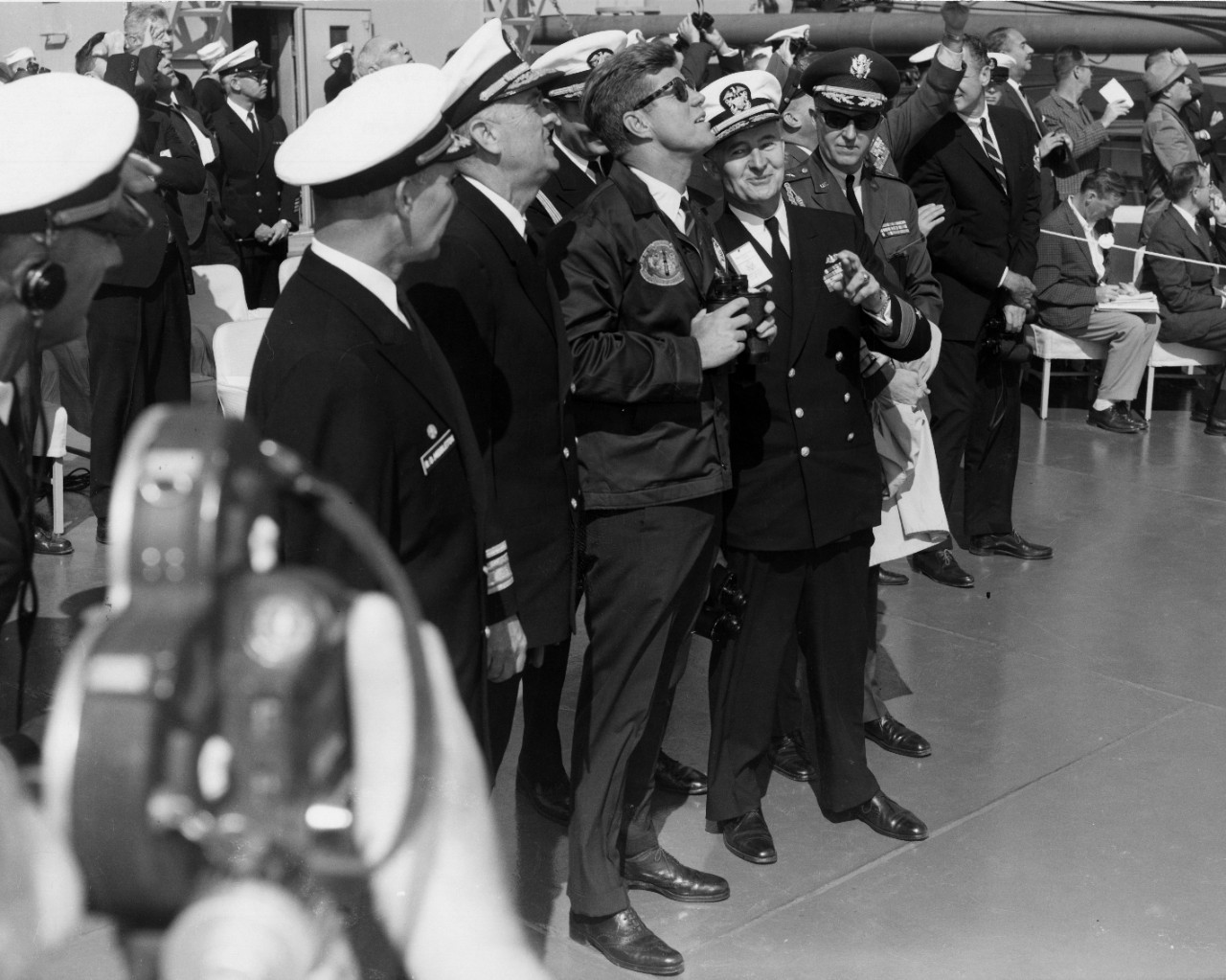
President John F. Kennedy observes the firing of a Polaris missile by USS Andrew Jackson (SSBN-619) aboard the USS Observation Island off the coast of Florida, 16 November 1963. (NHHC L55-15.02.09)
Over time, the Navy built three versions of the Polaris missile: the A-1, A-2, and A-3. Between 1960 and 1971, Polaris served as the Navy’s sea-launched ballistic missile, with each successive version increasing its range and accuracy. In 1960, the A-1 Polaris missile had a range of 1,200 miles with a circular error probability of two nautical miles. By 1964, the A-3 missile had more than doubled Polaris’ range to 2,500 miles and lessened the circular error probability to a half mile. In 1966, the A-3 Polaris missile received upgrades to increase engine performance and add the capability for a single missile to deliver multiple warheads to a single target (MRV capability), making the missile’s accuracy even more deadly.[2]
The Navy built 41 Fleet Ballistic Missile submarines in seven and a half years. Five George Washington-class SSBNs were built between 1959 and 1961 from modified Skipjack designs. They put to sea armed with A-1 or A-2 missiles but were later refit with the A-3. Unlike the George Washington-class vessels, the Ethan Allen-class and all later SSBNs were originally designed to carry ballistic missiles. The Navy built five Ethan Allen-class boats between 1961 and 1963, equipping them with the A-2 and later the A-3 missiles. Between 1963 and 1967, the Navy built 19 Lafayette and James Madison-class and 12 Benjamin Franklin-class SSBNs. The first eight of these vessels built were armed with the A-2 missile and the rest with A-3 missiles equipped with the MRV capability. By 1966, the U.S. Navy had built 41 Fleet Ballistic Missile submarines, dubbed “41 for Freedom,” loaded with a combined total of 656 missiles.
Between 1971 and 1974, all Lafayette, Madison, and Franklin-class submarines converted to Poseidon missile capability. The Poseidon (C-3) weighed nearly twice as much as the Polaris A-3 but carried four times the payload while increasing accuracy to a circular error probability of a quarter mile. Moreover, it was capable of a longer range and could incorporate multiple independently targeted re-entry vehicles, or MIRV technology, meaning one missile could deliver multiple warheads to multiple targets.
In the early 1970s, the Navy began planning a modernization of its Fleet Ballistic Missile program. The result was the Trident I missile and the Ohio-class SSBN. The Trident I (C-4) missile deployed in 1979 and continued in service until 2005. Replacement of the C-4 began in 1990 with the initial deployment of the first Trident II (D-5) missile. Both Trident missiles continued to improve over previous missiles in range and accuracy. Armed with 24 Trident I missiles, the Ohio-class SSBNs entered service in 1981 as the largest ballistic missile submarines ever built for the U.S. Navy. In total, 18 SSBNs were built, but between 2002 and 2008, the four oldest, Ohio (SSBN-726), Michigan (SSBN-727), Florida (SSBN-728), and Georgia (SSBN-729), were converted to SSGNs[3] and armed with cruise and anti-ship missiles.[4] The conversions provided covert platforms capable of carrying up to 154 Tomahawk missiles (or other non-strategic[5] land attack missiles) and 66 SEAL special operations forces (SOF) personnel.[6] The remaining 14 Ohio-class SSBNs have since upgraded to the Trident II. With its improved range and accuracy, the Trident II missile can target virtually any point on the earth. Combined with the Ohio-class platform’s continued ability to stay at sea for extended periods of time and increased stealth capability, Trident II increased the assurance of retaliation in case of a first strike.
The first of the 14 Ohio-class SSBNs to reach the end of its 42-year service life will be Henry M. Jackson (SSBN-730) in 2027. The remaining 13 SSBNs will reach the end of their service lives at a rate of roughly one ship per year thereafter, with the last Ohio-class SSBN reaching the end of its service life in 2040. They will be replaced by the Columbia-class vessels, which will result in a new class of 12 ballistic missile submarines. The Navy has initiated a program to refurbish and extend the service lives of its current Trident II D-5 missile to 2040. As the new Columbia-class SSBNs begin to come online, refurbished D-5s carried by retiring Ohio-class boats will be transferred to the new SSBNs. Columbia-class SSBNs will continue to carry refurbished D-5s until about 2040, at which time they will be replaced by a new ballistic missile.[7] For the last 61 years, the Navy’s Fleet Ballistic Missile program, with its state of the art stealth, on-station sustainability, and massive second-strike ability, has served this nation well as the most reliable leg of America’s nuclear triad. It will continue to serve as a deterrent to our enemies well into the 21st century and beyond.
─Randall Fortson, NHHC Histories and Archives Division, February 2021
_______________________________________________
[1] Nuclear propulsion allowed Nautilus to remain submerged longer than diesel-electric submarines. Submarines that could stay at sea longer potentially offered a more reliable missile launching platform and increased deterrence.
[2] MRV, or multiple reentry vehicle, indicates multiple nuclear payloads for a single target. MIRV, or multiple independently-targeted reentry vehicle, indicates multiple nuclear payloads capable of striking multiple targets.
[3] Ship, Submersible, Guided Missile, Nuclear, or SSGN, is sometimes referred to as a cruise missile submarine that can carry nuclear or conventional missiles.
[4] Ronald O’Rourke, Navy Trident Submarine Conversion (SSGN) Program: Background and Issues for Congress, CRS Report No. RS21007 (Washington, DC: Congressional Research Service, 22 May 2008), 1–2.
[5] Non-strategic implies a weapon capable of delivering a conventional high-explosive warhead as opposed to one designed to deliver the mass destruction of a thermonuclear explosion.
[6] O’Rourke, Navy Trident Submarine Conversion, 3–4.
[7] Ronald O’Rourke, Navy Columbia (SSBN-826) Class Ballistic Missile Submarine Program: Background and Issues for Congress, CRS Report No. R41129 (Washington, DC: Congressional Research Service, 15 January 2021), 3.

